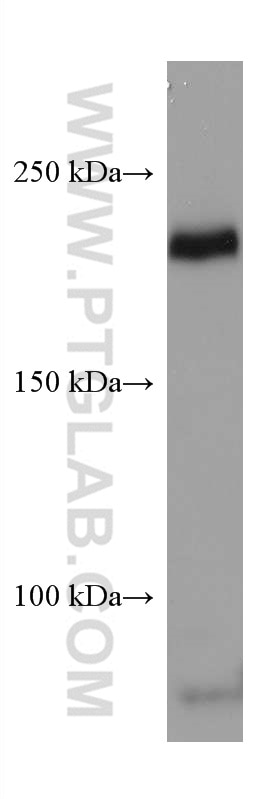Anticorps Monoclonal anti-VEGFR2/KDR
VEGFR2/KDR Monoclonal Antibody for WB, ELISA
Hôte / Isotype
Mouse / IgG1
Réactivité testée
Humain
Applications
WB, ELISA
Conjugaison
Non conjugué
CloneNo.
1G2A8
N° de cat : 67407-1-PBS
Synonymes
Galerie de données de validation
Informations sur le produit
67407-1-PBS cible VEGFR2/KDR dans les applications de WB, ELISA et montre une réactivité avec des échantillons Humain
| Réactivité | Humain |
| Hôte / Isotype | Mouse / IgG1 |
| Clonalité | Monoclonal |
| Type | Anticorps |
| Immunogène | VEGFR2/KDR Protéine recombinante Ag24589 |
| Nom complet | kinase insert domain receptor (a type III receptor tyrosine kinase) |
| Masse moléculaire calculée | 1356 aa, 152 kDa |
| Poids moléculaire observé | 230 kDa |
| Numéro d’acquisition GenBank | BC131822 |
| Symbole du gène | KDR |
| Identification du gène (NCBI) | 3791 |
| Conjugaison | Non conjugué |
| Forme | Liquide |
| Méthode de purification | Purification par protéine G |
| Tampon de stockage | PBS only |
| Conditions de stockage | Store at -80°C. 20ul contiennent 0,1% de BSA. |
Informations générales
KDR, also named as VEGFR-2, FLK1 and CD309, is a receptor for VEGF or VEGFC. KDR which belongs to the protein kinase superfamily, has a tyrosine-protein kinase activity. The VEGF-kinase ligand/receptor signaling system plays a key role in vascular development and regulation of vascular permeability. In case of HIV-1 infection, the interaction with extracellular viral Tat protein seems to enhance angiogenesis in Kaposi's sarcoma lesions. KDR functions as the main mediator of VEGF-induced endothelial proliferation, survival, migration, tubular morphogenesis and sprouting. Mutations of this gene are implicated in infantile capillary hemangiomas.



